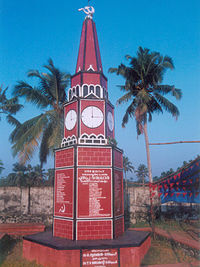Punnapra-Vayalar Struggle
| Punnapra-Vayalar Uprising | |||||||
|---|---|---|---|---|---|---|---|
| Part of Communist Movements in Travancore against the Diwan | |||||||
 Memorial of Punnapra-Vayalar uprising martyrs located near Kalarcode, Alappuzha |
|||||||
|
|||||||
| Belligerents | |||||||
|
|
Laborers in Punnapra and Vayalar |
||||||
| Commanders and leaders | |||||||
| K. Kelappan | T. V. Thomas | ||||||
| Casualties and losses | |||||||
| 40 deaths | More than 1,000 people dead | ||||||
The Punnapra-Vayalar uprising (October, 1946) was a communist uprising in the Princely State of Travancore, British India against the Prime Minister, C. P. Ramaswami Iyer and the state. Communist Party members were killed by the army of the Diwan (Prime Minister), 470 people at Punnapra on 27 October and more than 150 at Vayalar on 28 October. The total loss of life is allegedly estimated to be more than a thousand.
Historians like Prof Sreedhara Menon (though one website claimed that he had retracted his views later) maintain this was a proper struggle against the declaration of 'Independent Travancore' by the then Travancore government. T K Varghese Vaidya, a leader of the struggle, had gone on record saying it was a rehearsal for a larger revolution with the ultimate objective of establishing a "Communist India".
Sir CP Ramaswami Iyer had proposed constitutional reforms making Travancore an independent country. CP had proposed an 'American model' for Travancore. The Communists in Travancore opposed this move with the slogans, 'Chuck the Americans and British agents into the Arabian Sea'. The struggle against the Travancore Kingdom began in 1939 when the merger of socialist parties, which created a new radical communist party. The brutal famine conditions in Travancore Kingdom during the Second World war (WW2) had pushed the peasants towards the Communists. 21000+ peasants died in Cherthala taluk alone during the Famine (1939-43). Discontent in Cherthala & Ambalapuzha taluks grew against Diwan. In March 1946, Alappuzha was filled up by Travancore Police to crack down the members of ATTUC (All Travancore Trade Union Congress).
In response, over 2000 communists attacked police stations all across Alappuzha and practically established their own communist government. The communist government was established from Cherthala to Ambalapuzha, a stretch of 40km in Alappuzha. The communist cadres in Alappuzha were given military training by ex-servicemen who had returned home from World War 2. The communist cadres were armed with country weapons, especially varikundams (spears made out of arecanut tree stems).
...
Wikipedia
